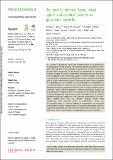Files in this item
The price of defence : toxins, visual signals and oxidative state in an aposematic butterfly
Item metadata
| dc.contributor.author | Blount, J.D. | |
| dc.contributor.author | Rowland, H.M. | |
| dc.contributor.author | Mitchell, C. | |
| dc.contributor.author | Speed, M.P. | |
| dc.contributor.author | Ruxton, G.D. | |
| dc.contributor.author | Endler, J.A. | |
| dc.contributor.author | Brower, L.P. | |
| dc.date.accessioned | 2023-01-31T16:30:12Z | |
| dc.date.available | 2023-01-31T16:30:12Z | |
| dc.date.issued | 2023-01-25 | |
| dc.identifier | 283182278 | |
| dc.identifier | 55744efc-f5c2-41a0-acc9-4461ef5e3371 | |
| dc.identifier | 85146411310 | |
| dc.identifier | 000914748200014 | |
| dc.identifier.citation | Blount , J D , Rowland , H M , Mitchell , C , Speed , M P , Ruxton , G D , Endler , J A & Brower , L P 2023 , ' The price of defence : toxins, visual signals and oxidative state in an aposematic butterfly ' , Proceedings of the Royal Society B: Biological Sciences , vol. 290 , no. 1991 , 20222068 . https://doi.org/10.1098/rspb.2022.2068 | en |
| dc.identifier.issn | 1471-2954 | |
| dc.identifier.other | RIS: urn:B91A835877E1266806781ADA87D9BDFF | |
| dc.identifier.other | ORCID: /0000-0001-8943-6609/work/128097436 | |
| dc.identifier.uri | https://hdl.handle.net/10023/26868 | |
| dc.description | Funding: J.D.B. was supported by a Royal Society University Research Fellowship. H.M.R., G.D.R. and M.P.S. were supported by NERC (NE/D010 667/1) during data collection, and H.M.R. was supported by a Junior Research Fellowship from Churchill College, Cambridge and the Max Planck Society during data analysis and manuscript preparation. | en |
| dc.description.abstract | In a variety of aposematic species, the conspicuousness of an individual's warning signal and the quantity of its chemical defence are positively correlated. This apparent honest signalling is predicted by resource competition models which assume that the production and maintenance of aposematic defences compete for access to antioxidant molecules that have dual functions as pigments and in protecting against oxidative damage. To test for such trade-offs, we raised monarch butterflies (Danaus plexippus) on different species of their milkweed host plants (Apocynaceae) that vary in quantities of cardenolides to test whether (i) the sequestration of cardenolides as a secondary defence is associated with costs in the form of oxidative lipid damage and reduced antioxidant defences; and (ii) lower oxidative state is associated with a reduced capacity to produce aposematic displays. In male monarchs conspicuousness was explained by an interaction between oxidative damage and sequestration: males with high levels of oxidative damage became less conspicuous with increased sequestration of cardenolides, whereas those with low oxidative damage became more conspicuous with increased levels of cardenolides. There was no significant effect of oxidative damage or concentration of sequestered cardenolides on female conspicuousness. Our results demonstrate a physiological linkage between the production of coloration and oxidative state, and differential costs of sequestration and signalling in monarch butterflies. | |
| dc.format.extent | 10 | |
| dc.format.extent | 872557 | |
| dc.language.iso | eng | |
| dc.relation.ispartof | Proceedings of the Royal Society B: Biological Sciences | en |
| dc.subject | Aposematism | en |
| dc.subject | Cardenolides | en |
| dc.subject | Danaus plexippus | en |
| dc.subject | Honest signalling | en |
| dc.subject | Oxidative lipid damage | en |
| dc.subject | Resource competition | en |
| dc.subject | QL Zoology | en |
| dc.subject | DAS | en |
| dc.subject | MCC | en |
| dc.subject.lcc | QL | en |
| dc.title | The price of defence : toxins, visual signals and oxidative state in an aposematic butterfly | en |
| dc.type | Journal article | en |
| dc.contributor.institution | University of St Andrews. School of Biology | en |
| dc.contributor.institution | University of St Andrews. Centre for Biological Diversity | en |
| dc.contributor.institution | University of St Andrews. Institute of Behavioural and Neural Sciences | en |
| dc.identifier.doi | https://doi.org/10.1098/rspb.2022.2068 | |
| dc.description.status | Peer reviewed | en |
This item appears in the following Collection(s)
Items in the St Andrews Research Repository are protected by copyright, with all rights reserved, unless otherwise indicated.

